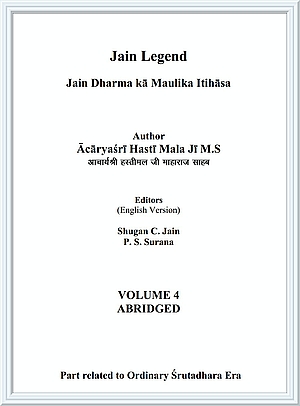Ācārya Malayagiri was a great author of Vṛttis in 17th Century V.N. (Vikram 12th century). In spite of penning a great number of verses summing up to 196600 and more, he did not furnish any introduction about himself.
At present only 20 Vṛttis on scriptures written by him are available. They are:
| NAME OF THE SCRIPTURE | NO. OF VERSES | |
| 1 | BhagavatīSūtra dwitīya śataka Vṛtti | 3750 |
| 2 | Rājapraśnīyopāṃga ṭīkā | 3700 |
| 3 | Jīvājīva abhigamopāṃgaṭīkā | 16000 |
| 4 | Prajṅāpanopāṃga ṭīkā | 16000 |
| 5 | Candraprajṅaptyupāṃgaṭīkā | 6500 |
| 6 | Sūryaprajṅaptyupāṃgaṭīkā | 6500 |
| 7 | Nandīsūtraṭīkā | 7732 |
| 8 | Vyavahārasūtra Vṛtti | 34000 |
| 9 | Bṛhatkalpapīṭhikā Vṛtti (incomplete) | 4600 |
| 10 | Āvaśyaka Vṛtti (incomplete) | 18000 |
| 11 | Piṃḍaniryukti ṭīkā | 6700 |
| 12 | Jyotiṣkaraṃḍa ṭīkā | 5000 |
| 13 | Dharmasaṃgrahaṇī Vṛtti | 10000 |
| 14 | Karmaprakṛti Vṛtti | 8000 |
| 15 | Paṃcasaṃgraha Vṛtti | 18850 |
| 16 | Ṣaḍaśīti Vṛtti | 2000 |
| 17 | Saptatikā Vṛtti | 3780 |
| 18 | Vṛhatsaṃgrahaṇī Vṛtti | 5000 |
| 19 | Bṛhatkṣetrasamāsa Vṛtti | 9500 |
| 20 | Malayagiri śabdānuśāsana | 5000 |
Apart from the Vṛttis mentioned above, the other works authored by Ācārya Malayagiri were mentioned in his works, but they are unavailable now.
The following books of Ācārya Malayagiri are not available:
- Jambūdwīpa Prajṅapti Ṭīkā
- Oghaniryukti Ṭīkā
- Viśeṣāvaśyaka Ṭīkā
- Tatvārthādhigama Sūtra Ṭīkā
- Dharmasāraprakaraṇa Ṭīkā
- Devendra Narendra Prakaraṇa Ṭīkā
Ācārya Malayagiri was contemporary ācārya to Ācārya Hemacandra Sūri, the omniscient of Kaliyuga. He was influenced by the unfathomable knowledge of Hemacandra Sūri and he considered the latter as his guru.
The cogitative Ācārya Malayagiri by writing 20 Vṛttis on scriptures improved and facilitated the path of spiritual practice of salvationdesiring devotees (mumukṣus). Jain world is eternally indebted to him for his remarkable 'worship of scriptures (Śrutārādhanā').
Ācārya Abhayadeva Maladhārī
During the period between first half of the Vikram 12th century up to its second half, Maladhārī Ācārya Abhayadeva remained as a powerful propagator and an influential ācārya. He was a renowned ācārya of Kauṭika gaṇa Praśnavāhana lineage (kula) Madhyama Śākhā (branch), Harṣapurīya gaccha. It was mentioned in the unauthentic inscriptions of succeeding times, that he travelled far and wide.
He was the disciple of Ācārya Jayadeva Sūri of Harṣapurīya gaccha. He was a great renouncer. On the basis of eulogy of 'Muni Suvrata Caritra' authored by Candra Sūri, his grand disciple (Praśiṣya), the King of Gurjara Siddharāja was very much impressed by the supreme renunciation of Abhayadeva Maladhārī. To eradicate the perverted lax spiritual practice of laity, and to uplift his soul and that of others, he firmly decided to observe the pure code of conduct prescribed for Śramaṇas. He did not even bother to clean his clothes and body. As a result, his clothes and body were covered with dust and appeared discoloured. Impressed by his extreme dispassion and detachment, the King of Gurjara, Siddharāja Jayasiṃha adorned him with the title 'Maladhārī'. Some scholars opine that the title 'Maladhārī' was bestowed by his predecessor king 'Karṇa' and not by Siddharāja. The historians, on the basis of authentic historical evidences concluded that the regime of Karṇa the King of Gurjara to have extended from Vikram 1129 to 1151 and that of Siddharāja from Vikram 1151 to 1200. The tenure of Maladhārī Ācārya Abhayadeva Sūri was estimated as Vikram 1135 to Vikram 1160. Irrespective of whether the title was given by King Karṇa or by King Siddharāja, there is no doubt in the fact that the Gurjara king of his times, impressed by his extreme dispassion honoured him with this title.
According to the eulogy of 'Muni Suvrata Caritra' Maladhārī Abhayadeva Sūri fasted for 45 days observing Saṃlekhanā (physical / mental mortification for a holy death). When King Siddharāja was informed of his fasting unto death, he came to Ajmer to behold his Darśana. After 45 days of fasting when Abhayadeva Sūri left his mortal body for heavenly abode, the people of Ajmer and of neighbouring places, young and old alike, flocked to pay homage and join the procession of his last journey. They thronged to take the ashes remaining after cremating his body as they firmly believed that the ash of such a great renouncing-yogī would cure any type of disease. When there was no more ash left, they started taking even the soil from the place where he was cremated. Thus a very big crevasse formed there.
His renunciative austere and self-contemplative life left a deep impression on his disciples and devotees. Hence even after his quietus, a tradition by his title 'Maladhārī' remained popular for thousands of years.
 Acharya Hasti Mala
Acharya Hasti Mala
